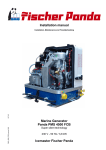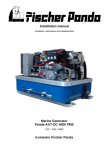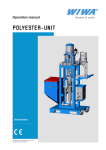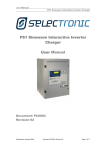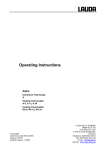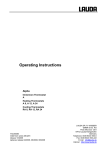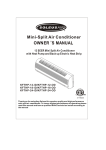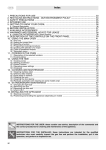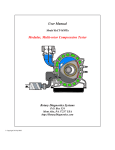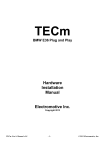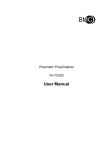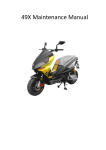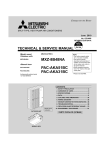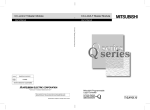Download Installation Manual Panda PVMV-N 9.000ND Super silent
Transcript
Installation Manual Installation, Maintanance and Troubleshooting Panda PVMV-N 9.000ND Super silent technology 230V - 50 Hz / 7,5kW Icemaster Fischer Panda 30 20 10 10 10 since 1972 Established in the Marine technology since 1978 Fischer Marine Generators since 1988 Conclusion Fischer Icemaster GmbH since 1988 100 % water cooled Panda generators since 1988 Panda Vehicle Generators Fischer Panda FISCHER GENERATORS have been manufactured since 1978 and are a well-known brand for first class diesel generators with especially effective sound-insulation. Fischer has been one of the leading manufacturers in respect of quality and know-how during this period. FISCHER, as the worldwide manufacturer of modern marine diesel generators, developed the Sailor-Silent series for example and produced a GFK sound-insulated capsule as early as 1979 and the basis for new generator technology. The companies Fischer and Icemaster amalgamated under the direction of Icemaster in 1988, in order to concentrate on the development of new products. Production was moved to Paderborn. The amalgamation of the two qualified companies led to the development of a complete new programme within a short space of time. The aggregates developed at that time set new technological standards worldwide. The aggregates became more efficient and powerful than other aggregates in the same nominal performance range, because of the improved cooling. Panda generator demonstrated its superiority in several tests by renowned institutes and magazines during the past years. The patented VCS (voltage Control System) means it can meet all demands including motor speed. The start-booster (ASB) means Panda generators meet the highest demands in respect of voltage stability and starting values A Panda generator, with the same drive motor, produces 15% more effective output than the majority of conventional generators. This superiority in efficiency also ensures a fuel saving to the same extent. The 100% water-cooled Panda Aggregate are currently manufactured in the performance range from 2 to 100 kW in various versions. Fast running motors are preferred for performances up to approx 30 kW (Nominal speed 3000 rpm). The heavier slow runners are preferred for the higher range. The fast running aggregates have proved themselves many times for many uses, that they meet the demands in quality of yachts and vehicles, and offer space and weight saving of 50% compared to slow running generators. In addition to the Panda series, Icemaster also supply the super compact high-tech sound-insulated battery charging aggregate from the DC/AC Panda AGT series, which is a very interesting solution for the production of mobile power. The new HTG-alternators ensure that a charging rate of 285 amps is achieved that was scarcely thought possible for this compact construction. This alternator replaces a separate shipboard generators (constant 230 volts AC with up to 3500 kW from the main machine) ICEMASTER GmbH, 33104 Paderborn, reserves all rights regarding text and graphics. Details are given to the best of our knowledge. No liability is accepted for correctness. Technical modifications for improving the product without previous notice may be undertaken without notice. Before installation, it must be ensured that the Pictures, diagrams and related material are applicable to the aggregate supplied. Enquiries must be made in case o doubt. ii CALIFORNIA Proposition 65 Warning Diesel engine exhaust and some of its constituents are known to the State of California to cause cancer, birth defects, and other reproductive harm. Attention, Important Directions regarding Operation! 1. The installation certificate must be completed when taken into use, and certified by a signature. 2. The installation certificate must be despatched within two weeks of use to ICEMASTER. 3. The official guaranty confirmation will be completed by ICEMASTER after receipt and sent to the customer. 4. A guaranty must be shown to make any claims. Claims against the guaranty will not be accepted of the above said instructions are not, or only partially, carried out. Manufacturer declaration in terms of the machine guideline 98/37/EG . The generator is in such a way developed that all assembly groups correspond to the CE guidelines. If machine guideline 98/37/EG is applicable, then it is forbidden to bring the generator into operation until it has been determined that the system into which the generator is to be installed in also corresponds to the regulations of the machine guideline 98/37/EG. This concerns among other things the exhaust system, cooling system and the electrical installation. The evaluation of the "protection against contact" can only be accomplished in connection with the respective system. Likewise among other things responsibility for correct electrical connections, a safe ground wire connection, foreign body and humidity protection, protection against humidity due to excessive condensation as well as the overheating through appropriate and inappropriate use in its installed state on the respective machine lies within the responsibility of those who undertake installation of the generator in the system. Technical Support per Internet: [email protected] iii Safety Instructions Electrical installation is only allowed to be fitted by trained and examined personnel ! The generator may not be taken into use with the cover removed. The rotating parts (belt-pulley, belts, etc) must be so covered and protected do that there is no danger to life and body! If a sound insulation covering must be produced at the place of installation, then well-placed signs must show that the generator can only be switched on with a closed capsule. All servicing-, maintenance or repair work may only carried out, when the motor is not running. Electrical voltages above 48 volts ( battery chargers greater than 36 volts) are always dangerous to life). The rules of the respective regional authority must be adhered to. Only an electrician may carry out installation of the electrical connections for safety reasons. Protective Conductor: The generator is „earthed " as standard (The centre and earth are connected by means of a bridge in the generator terminal box). This is a basic safety function, which offers basic safety as long as no other component has been installed. It is, above all, conceived for supply and an eventual test run. This "earth" (PEN) is only effective, if all parts of the electrical system is earthed, and has a common “potential”. The bridges can be removed, if this is required for technical reasons and another protection system has been installed. The full voltage is exploited at the AC control box, when the generator is run. It must therefore be ensured that the control box is closed and cannot be tampered with, if the generator is running. The battery must always be disconnected, if work on the generator or electrical system is to be carried out, so that the generator cannot be unintentionally started. It is not allowed to disconnect the battery during operation! After the generator has stopped the battery can be disconnected! Switch off all consumers when working on the generator All consumers must be disconnected, in order to avoid damages to the devices. In addition the semi conductors in the AC control box must be disconnected in order to avoid the boat capacitors being activated. The minus pole of the battery ought to be removed. Capacitors are required to run the generator. These have two varying functions: A) The working capacitors B) The (Booster) capacitors Both Groups are located in a separate AC-Control box. Capacitors are electrical stores. There could be a residual of high electrical current at the contacts for a period disconnection from the circuit. The contacts my not be touched for safety reasons, If the capacitors are to be exchanged or checked, then a short circuit between the contacts should be made so that the stored energy is discharged. If the generator is switched off in the normal manner, the working capacitors are automatically discharged by means of the windings. The booster capacitors are discharged by means of internal discharge resistors. All capacitors must be short-circuited before work is carried out on the AC-Control box for safety reasons. iv Table of contents A Generator Operating Instructions ....................................................................................3 A.1 Safety Instructions ................................................................................................................ 3 A.1.1 A.1.2 A.1.3 A.1.4 B B.1 Maintenance Requirements .................................................................................................. 7 B.2 Oil Circuit Maintenance ........................................................................................................ 7 B.3 De-aerating of the coolant circuit ...................................................................................... 10 B.4 Air-bleeding of the Fuel System ........................................................................................ 12 Exchange of the fuel filter ........................................................................................................ 13 B.5 Exchange the air filter ......................................................................................................... 14 B.6 Exchange of the V-belt ........................................................................................................ 15 Generator Failure .............................................................................................................17 C.1 Overloading the Generator ................................................................................................. 17 C.1.1 C.1.2 C.1.3 C.1.4 C.1.5 Generator Voltage Fluctuations and Monitoring ...................................................................... Automatic Voltage Monitoring and Auto-Shut Down ............................................................... Low Generator Output Voltage................................................................................................ Checking the Generator Voltage ............................................................................................ Checking the Capacitors ......................................................................................................... 18 18 18 19 20 C.2 Testing Generator Stator Winding for "Shorts" to Ground ............................................. 22 C.3 Coil Resistance Measurements in Stator Windings ......................................................... 22 C.3.1 C.3.2 C.4 C.5 Measuring the Coil Inductive Resistance ................................................................................ 23 Rotor Magnetism Loss and "Re-magnetizing"......................................................................... 24 Starting Problems ............................................................................................................... 25 C.4.1 C.4.2 D 3 3 4 4 Maintenance Instructions ..................................................................................................7 B.4.1 C Protection Conductor:................................................................................................................ Instructions for Capacitors......................................................................................................... Overloading of Engine during longer Operation ........................................................................ Operating Control System on the Panda Generator ................................................................. Fuel Solenoid Valve ................................................................................................................ 25 Failure Bypass Switch ............................................................................................................. 26 Troubleshooting Table ........................................................................................................ 26 Installation Instructions ..................................................................................................27 D.1 Generator Connections ...................................................................................................... 27 D.1.1 D.1.2 D.1.3 D.1.4 D.1.5 D.1.6 General Instructions ................................................................................................................ Connections ............................................................................................................................ Fuel System Installation .......................................................................................................... Connection to 12V Starter Battery-Block................................................................................. Connection of electrical components ...................................................................................... Connection of the external radiator ......................................................................................... 27 27 28 29 30 31 D.2 AC-Control box .................................................................................................................... 32 D.3 The fan control .................................................................................................................... 33 D.4 Cooling system .................................................................................................................... 34 D.5 Exhaust installation ............................................................................................................ 47 Panda 9000ND PVMV-N - Table of contents - Page 1 E Page 2 Appendix ............................................................................................................................. I E.1 Maintenance intervalls ...........................................................................................................I E.2 Engine oil ............................................................................................................................... II E.3 Coolant specifications .........................................................................................................III E.4 Troubleshooting .................................................................................................................. IV E.5 Technical Data Engine ...................................................................................................... VIII E.6 Technical Data Generator ................................................................................................. VIII E.7 Wiring diagram remote control panel ................................................................................ IX Panda 9000ND PVMV-N - Table of contents Generator Operating Instructions A. Generator Operating Instructions A.1 Safety Instructions Do not run the generator with an open capsule! There are dangerous rotating machine components which could cause injury. All servicing, maintenance and repair works must be carried out with the generator switched off. High Voltage DANGER ! The genset output Voltages can all be lethal. Ensure that all electrical installations comply with all required regulations of the regional authorities. The electrical installation should be performed by a qualified technician. A.1.1Protection Conductor: The standard Panda generator is grounded. The 3-phase connection (delta) centre point is bridged to earth in the AC output terminal box (mounted on the generator). This is the initial earth safety point and is sufficent to ensure safe operation however only as long as no other system is installed. This system is adapted to enable test running of the generator before delivery. The bridge to ground (PEN) is only effective when all components in the electrical system share a common ground. The bridge to ground can be removed and reconnected to another ground system if required for other safety standards. Full voltage connections are mounted in the electrical cabinet. It must be ensured that the electrical cabinet is secured and closed while the generator is running. The starter battery cable should be disconnected when work is being done on either the generator or the electrical system in order to prevent accidental starting of the generator. A.1.2Instructions for Capacitors The generator's electrical system requires two different groups of capacitors: A) The booster capacitors B) The operating capacitors Both types are mounted in the electrical cabinet. Capacitors store an electrical charge. It is possible that even after they have been disconnected stored energy is still held. Therefore it is essential that the connectors are not touched. Should it be necessary to check or test the capacitors, they should be shorted out by using an insulated screw driver. The operating capacitors are automatically discharged when the generator is stopped in the normal way. The booster capacitors will be discharged through internal resistor´s. For safety however, the capacitors have to be discharged (short circuited) prior to carrying out any work on the AC-Control box. CAUTION! Do not touch the capacitor contact terminals! Panda 9000ND PVMV-N - Chapter A: Generator Operating Instructions Page 3 Generator Operating Instructions A.1.3Overloading of Engine during longer Operation Please ensure that the genset is not overloaded. Overloading occurs when the electrical load (demand) induces a load torque in the generator which is higher than that which the diesel drive motor can provide. Overloading causes the engine to run rough, burn oil, creates excessive exhaust (environmentally unfriendly) and even to stall. Extra caution should be practised with multi-power units (single and 3-phase current generation) to avoid overloading the diesel drive engine. The generator should only be loaded at the peak rated power for short periods only! A high peak current is required to start many electrical devices, especially electric motors and compressors (from a still stand state). Please ensure that the genset is not overloaded. Overloading occurs when the electrical load (demand) induces a load torque in the generator which is higher than that which the diesel drive motor can provide. Overloading causes the engine to run rough, burn oil, creates excessive exhaust (environmentally unfriendly) and even to stall. Extra caution should be practised with multi-power units (single and 3-phase current generation) to avoid overloading the diesel drive engine. The generator should only be loaded at the peak rated power for short periods only! A high peak current is required to start many electrical devices, especially electric motors and compressors (from a still stand state). A.1.4Operating Control System on the Panda Generator Panda generators are equipped with various sensors. One of these sensors is to stop excitation should a short circuit occur. The combustion engine is further equipped with a oil pressure control switch, which switches the motor off, if the oil pressure sinks to a particular level. Apart from this, all generators are equipped with four temperature switches. The thermo-switches are placed at the following locations: 1. Thermo-switch fitted to the cylinder head 2. Thermo-switch fitted to the exhaust manifold 3. Thermo-switch fitted to the silencer 4. Thermo-switch fitted to the front plate 5. Thermo-switch in the genset coil 6. Oil pressure switch Page 4 Panda 9000ND PVMV-N - Chapter A: Generator Operating Instructions Generator Operating Instructions Thermo-switch at cylinder head Fig. A.1: Thermo-switch cylinder head Thermo-switch at water-cooled exhaust elbow Fig. A.2: Thermo-switch at exhaust manifold Thermo-switch at pre-silencer Fig. A.3: Thermoschalter am Abgasanschluss Panda 9000ND PVMV-N - Chapter A: Generator Operating Instructions Page 5 Generator Operating Instructions Thermo-switch at the front plate Fig. A.4: Thermo-switch at front plate Thermo-switch at coil 01. Thermo-switch coil 160°C 02. Generator housing 01 02 Fig. A.5: Thermo-switch coil Oil pressure switch Fig. A.6: Oil pressure switch Page 6 Panda 9000ND PVMV-N - Chapter A: Generator Operating Instructions Maintenance Instructions B. Maintenance Instructions B.1 Maintenance Requirements Control before starting • Oil level • Cooling system leaks • Visual check for any changes, leaks oil drain system, v-belt, cable connections, hose clips, air filter, fuel lines Once a week • Lubrication of actuator-trapezoid thread spindle For Maintenance Intervalls see Table E.1, “Maintenance intervalls,” on Page I B.2 Oil Circuit Maintenance The laid down intervals must be heeded in order to avoid serious damage to the motor! The first oil change should be carried out 35 hours after running time. Thereafter every 100 hours. SAE 30 is to be used for temperatures over 20°C and SEA 20 for temperatures between 5°C and 20°C. Viscosity SAE 10W or 10W-30 is laid down for temperatures below 5°C. Type and amount of required oil see: Table E.2, “Engine oil,” on Page II and Table E.5, “Technical Data Engine,” on Page VIII An oil drainage hose is fitted in the sound cover for changing the oil. This is fed through the capsule to the outside. Open the pass-through cover at the sound cover for the oil drain hose. Panda 9000ND PVMV-N - Chapter B: Maintenance Instructions Page 7 Maintenance Instructions The oil can then be drained by opening the oil drainage screw. If the oil cannot be drained we recommend the use of a hand pump, which can be connected to the oil drainage hose. The oil drainage screw is then closed again and the hose again stored in the sound-insulated capsule. The oil filter could be loosen by a tool (oilfilter strap) Page 8 Panda 9000ND PVMV-N - Chapter B: Maintenance Instructions Maintenance Instructions Oil filter seal ring Before reinsert the gasket of the new oil filter should be coated with something oil. Oil filler neck The new oil is filled here. With the help of the engine oil dipstick the oil level is too examined. The prescribed filling level may not exceed the „Max“ marking. Panda 9000ND PVMV-N - Chapter B: Maintenance Instructions Page 9 Maintenance Instructions B.3 De-aerating of the coolant circuit Particular hints for the de-aerating of the cooling system If the coolant has been drained or if air has permeated into the cooling system by other reasons, a careful ventilation of the cooling system is necessary. The de-aerating process has to be rerunned several times. Open de-aerating screw at the cooling water pump. Open de-aerating screw at the thermostathouing Open de-aerating screw at the watercooled silencer. Page 10 Panda 9000ND PVMV-N - Chapter B: Maintenance Instructions Maintenance Instructions Pour in coolant through the cooling water filler cap. The coolant flows in very slow. If it is to be recognized that the cooling water level does not sag any longer (with cold cooling water the cooling water level must cover the sheet metal in the exhaust elbow union), close the de-aerating screws and start the generator. Run the generator to maximally 60. Switch off generator. Open the cooling water filler neck again and also the de-aerating screws at the same time. Fill in again cooling water. Repeat this procedure several times. The generator can be started for 5 minutes, if there is no change. De-aerating must be then repeated two or three times. To be sure that the coolant circulates it is very important that the hose pipe away from the genset also gets warm. After a short time the radiator and the reverse-flow pipe from the radiator to the genset also get warm. Please wait until the temperatures raise more and check if the fan will activate. It makes sense to, once again, repeat the de-aerating procedure after a few days, in order to ensure that remaining air bubbles have been finally removed. Panda 9000ND PVMV-N - Chapter B: Maintenance Instructions Page 11 Maintenance Instructions B.4 Air-bleeding of the Fuel System Normally, the fuel system is designed to bleed out air itself i.e. as soon as the electric starter motor starts operation the fuel pump starts working and the fuel system will be air-bleed after some time automatically. It is nevertheless essential to bleed the system as follows prior to the first operation (as all hoses are empty): 1.) Switch the main power switch on control panel to "ON". 2.) Push failure bypass switch and hold tight. The electric fuel pump has to be running audibly. By moving the failure bypass switch you can hear the solenoid valve of the generator starting and stopping (when the sound cover is taken off). 3.) After the fuel pump has been running 3 to 4 minutes because the failure bypass switch has been pushed down the bleeding screw of the solenoid valve has to be unscrewed. When opening the screw one has to carry on pushing the switch. To avoid fuel getting in the sound cover a piece of cloth or absorbent paper should be put under the connection. As soon as fuel is running out without bubbles the air bleeding screw can be screwed in again. Now stop pushing the failure bypass switch. 4.) Now the unit can be started by pushing the "START"-button. The unit should start after a short while. Should the unit not start the pipe union nuts of the injection nozzles has to be loosen and lift the injection pipe a few millimeter. Try again to start the unit. After the unit has started the pipe union nut has to be tightened again. Page 12 Panda 9000ND PVMV-N - Chapter B: Maintenance Instructions Maintenance Instructions 5.) The injection line must be raised some millimeters. 6.) Main power switch "OFF". B.4.1 Exchange of the fuel filter The exchange of the filter depends on the contamination of the fuel, should take place at least all 300 operation hours. Before the exchange of the filter the inlet must be clamped. Remove the hoses from the used filter and fasten them to the new filter. The arrow on the filter housing indicates the direction of the fuel flow. A clogged filter causes a decreased power output of the generator Panda 9000ND PVMV-N - Chapter B: Maintenance Instructions Page 13 Maintenance Instructions B.5 Exchange the air filter Open the combustion air housing by loosen the clamp at the cover. Open the combustion air housing by loosen the clamp at the cover. Loose the wing bolt and lift the frame that holds the air filter. Change the air filter (MANN C2039). Page 14 Panda 9000ND PVMV-N - Chapter B: Maintenance Instructions Maintenance Instructions B.6 Exchange of the V-belt The relative high ambient temperature in the closed sound insulated capsule (about 85°C) can be a reason for a reduced lifespan of the v-belts. It is possible that the "softener" in the rubber compound lose their effect after a short operating time because the air in the sound insulated capsule can be relative warm and dry. The v-belt must be controlled in a very short time interval. It can be happen to change the v-belt after some weeks because of unfavorably conditions. Therefore the control is needed in an interval of 100 operating hours. The v-belt ia a wearing part. It should be enough spare v-belts on board. We suggest to stand by the according service-packet. Loosen the fixing screw above the alternator. Loosen the fixing screw below the alternator only a little bit. Panda 9000ND PVMV-N - Chapter B: Maintenance Instructions Page 15 Maintenance Instructions Press the alternator to the direction of the thermostat housing. Now the v-belt can be changed (type: XPZ 850). Stretch the v-belt by pulling the alternator back. The v-belt should be able to be pressing approx. 1cm with the thumb. Tighten the fixing srews above and below the alternator. Page 16 Panda 9000ND PVMV-N - Chapter B: Maintenance Instructions Generator Failure C. Generator Failure C.1 Overloading the Generator Please ensure that the genset is not overloaded. This is especially the case with multi-power aggregates. Overloading occurs when the electrical load (demand) induces a load torque in the generator which is higher than what the diesel drive motor can provide. Overloading causes the engine to run rough, burn oil, create excessive exhaust (environmentally unfriendly) and even to stall. The generator should only be loaded at the peak rated power for short periods only! A high peak current is required to start many electrical devices, especially electric motors and compressors (from a still stand state). In order to prolong the genset´s life expectancy, the nominal electrical demand on the system should not be more than 70% of the rated genset power. Bear this in mind when switching on electrical devices. This ensures a longer life expectancy. Continuous performance is the uninterrupted running of the generator for many hours. The genset can be run for several hours at partial load (i.e. 2/3 of rated power), however it is not advised that it is run for more than 2-3 hours at full load. The Panda is designed so as not to overheat even under extreme conditions. Note: The exhaust gas will become sooty during peak-load operation. Effects of Short Circuiting and Overloading on the Generator The generator cannot be damaged by short circuiting or overloading. Short circuiting and overloading suppress the magnetic excitation of the generator, thus, no current is generated and the voltage will collapse. This condition is immediately offset once the short-circuit has been eliminated and/or the electrical overload removed. Overloading the Generator with Electric Motors Please note that electric motors require six to ten times more power than their rated capacity to start. If the supplied generator power is lower than what the electric motor requires, the generator voltage will collapse. For applications where a high current draw is required to start an electrical device (such as an electric motor), the motor manufacturer should be consulted for possible solutions (for example: stronger capacitors, gradual power-up switches, or a specially designed starting unit for electric motors). System efficiency can be improved by up to 50% and motor current draw (to start) reduced by as much as 100% if it is properly designed. If the inductive load (i.e. E-Motor) is more than 20% of the generator nominal power, a compensation is necessary. See also the information brochure "Special information for operation of Panda generators with inductive load". Panda 9000ND PVMV-N - Chapter C: Generator Failure Page 17 Generator Failure C.1.1Generator Voltage Fluctuations and Monitoring ATTENTION! Before working (installation) on the System read the section Safety Instructions in this Manual. During periods of high electric loading, the voltage may drop to 190V/50Hz (or 95V/60Hz) or even lower. Such voltage drops can potentially cause damage to certain electrical devices such as electric motors, compressors and electronic equipment. In order to ensure that sufficient voltage is available and to avoid the risk of damage to sensitive electrical devices, the supply voltage should be monitored with the voltmeter, which is mounted at the operation unit. The voltmeter must be respectively checked if additional load is switched on. As long as the voltage remains below the critical level the sensitive devices must be switched off during this period. Overvoltage can be caused by the generator under certain circumstances. This occurs, especially if the speed of the motor changes (increases in speed). Adjustment to the normal motor speed (rpm) should only be done with the use of a rev counter and/or a voltmeter. A voltage regulated circuit breaker is installed in the electrical system in order to avoid damage, if sensitive or valuable equipment is used. (voltage control with circuit breaker). C.1.2Automatic Voltage Monitoring and Auto-Shut Down If air conditioning units (compressors) or other such valuable equipment are installed on-board, an automatic voltage monitoring unit should be installed to protect this equipment from possible sharp voltage drops. The voltage monitoring system shuts down the entire system (and therefore all users) through a circuit breaker relay as soon as the voltage falls below a set value (the monitor will also shut down the on board grid automatically when the generator is stopped). The monitoring system also switches the grid back on once the required voltage level is again reached. This ensures no damage is caused to the load and fittings through undervoltage. Such a voltage relay can be obtained from wholesale dealers or as a complete unit from PANDA dealers. The circuit is always automatically cut off if the generator is stopped. C.1.3Low Generator Output Voltage ATTENTION! Before working (installation) on the System read the section "Safety Instructions" in this Manual. Panda generators are designed such that even high electrical disruptions will not cause serious damage to the generator. If the generator does not produce any voltage while the diesel drive engine is running, the suspected cause lies outside the generator capsule. - electrical load not switched off prior to start - short circuit somewhere in electrical system - electrical overload Page 18 Panda 9000ND PVMV-N - Chapter C: Generator Failure Generator Failure C.1.4Checking the Generator Voltage In order to check the generator for faults, stop the generator and disconnect the connection cables between generator and system. Remove the cables at the connection terminal of the generator or, if installed, at the system distribution box. Make sure, there is no voltage on the cables before disconnecting. The capacitors also are to be discharged. ATTENTION! Never work at the electrical cabinet, when the generator is running! Do not contact the capacitor. Before working on the system read the section "Safety Instructions" in this manual. Capacitors After that, the generator should be restarted and the voltage checked at the terminals with a voltmeter. If the generator still does not supply sufficient voltage, the following steps must be undertaken: 1. Check the rev-speed of the motor. If the rev-speed is too low, the generator may not be able to achieve full magnetic excitation and thus the required output voltage. If the engine rotational speed is too high, the generator excitation will improve, but the generated voltage can also be too high. 2. If the rev-speed is normal and the output voltage is still outside the acceptable range, the capacitors should be inspected. Do not contact the capacitor terminals! Normally, however, it is highly unlikely that more capacitors than one are faulty. In the event that one or more of the capacitors are indeed faulty, the generated voltage will always be too low. With the system (electrical load) disconnected, and with the generator motor running, a weak generator voltage is a sure sign that at least one of the capacitors is faulty. An unusually warm capacitor is also a sign that it is faulty or near the end of its life span. Panda 9000ND PVMV-N - Chapter C: Generator Failure Page 19 Generator Failure C.1.5Checking the Capacitors ATTENTION! Before working (installation) on the System read the section "Safety Instructions" in this Manual. Do not check the capacitors whilst the generator motor is running! Charged capacitors can be lethal. Do not contact the capacitors with bare fingers or non-insulated metallic objects! In order to test the capacitors, the terminal lead wires have to be disconnected using pliers or a screwdriver with insulated handle(s). Once the wires have been removed, the capacitors must discharged by bridging the capacitor terminals together with a slot screwdriver with an isulated handle. Discharge the capacitor 1. Screw driver blade 2. Capacitor connections 1 3. Capacitor 3 2 The capacitors can be checked using a normal multimeter with a continuity beeper. Check that the multimeter "beeps" when the selector is set to continuity and the end probes are contacted together. Checking Switch the multimeter to „Continuity: acoustic signal“ and touch both capacitor terminals with the meter end probes. Page 20 Panda 9000ND PVMV-N - Chapter C: Generator Failure Generator Failure Test each capacitor by touching the multimeter (set on "continuity") end probes on the capacitor terminals: only a brief "beep" should be audible from the multimeter. Once this has been done, reverse the end probe positions and repeat the check. (The multimeter battery charges the capacitor and then the capacitor discharges quickly. The discharge to the multimeter "closes" the circuit briefly and continuity is achieved for a brief instant causing the short "beep".) If there is no beep at all or there is a continuous beep, then the capacitor(s) is faulty and needs to be replaced. Check all capacitors in the electrical cabinet The cables L1, Z and N leading from the generator must be clamped (see diagram beneath). Checking of the terminals must be carried out in the following order: 1. L1-N 2. Z-N The capacitors must not be removed from the electrical cabinet before a check is made. The procedure for checking the capacitors is given below. The "beep" must be the same period of time for all three checking processes. As long as a measuiring device is available to check the capacity, it is naturally better if the capacitors are checked with this measuring device. Checking the electrical connections to the Capacitor It must be ensured that the electrical connections to the capacitor are always tight fitting. Loose connections with transitional resistance can mean that the contact surfaces will become heated externally. This can lead to faster deterioration of the capacitors. ATTENTION! Do not contact the capacitor. Before working on the System read the Section "Safety instructions" in this Manual. AC Output Terminal box 230V-50Hz N L1 Z PE Panda 9000ND PVMV-N - Chapter C: Generator Failure Page 21 Generator Failure Wiring Diagram C.2 Testing Generator Stator Winding for "Shorts" to Ground If no faults are found with the capacitors and the generator is still not performing correctly, the generator stator windings must be tested for "shorts" to ground as follows: 1. Ensure that the generator is "OFF" and cannot be accidentally started. Disconnect the battery leads. 2. Remove AC output terminal box lid (mounted on generator casing). 3. All terminal box connections are to be removed. (See appropriate circuit diagram.) 4. Remove all cables (also earth lead). 5. A check of the generator terminal box is made by means of a multimeter to determine whether there is continuity between the individual windings connections and the casing (N): 50 Hz-System: L1-N, Z-N If continuity is detected for any of the combinations, the generator must be sent to the factory for inspection and repair. If this is not possible, the stator can be rewound by a qualified tradesperson/technician. Winding diagrams can be obtained from ICEMASTER GmbH, Germany, if necessary. This test, unfortunately, is carried out at very low voltage (9V) when a normal multimeter is used. Therefore only positive short circuits will be displayed. There is the possibility that a short circuit will occur in spite of a negative test result (i.e. moisture). A reliable check can only be carried by using an essentially higher voltage (approx 500V). This type of measuring instrument is normally only used by experts. If in doubt an electrician must check the winding for a short circuit with an isolation meter. C.3 Coil Resistance Measurements in Stator Windings When there are neither faults with the capacitors nor any low or high voltage "shorts" in the windings to ground, the windings should then be tested for the correct coils resistance (for shorts between wires within the coils). To measure coil resistance a meter capable of measuring low resistances (Milli-Ohm resolution if possible) accurately. The measured resistance values should be close to the same between the following terminals: L1-N, L1-Z. Page 22 Panda 9000ND PVMV-N - Chapter C: Generator Failure Generator Failure Checking windings. • Disconnect all the cables from the terminals in the AC-connection box. • Remove the Neutral- Ground connection. • Take all the winding connection cables from the terminal bolts. • Switch your meter in resistance range. When you put the probes of you meter together, you should get a reading of 0.00Ohm. When you isolate the probes, the reading will be Overflow. Please do this tests to check your meter. • Measure the resistance between the separate windings. Maybe the readings of your meter do not comply with the values of the table in the appendix. In every case the relation between the values should be the same. Some meters do not work fine, when values are very small. • Measure the resistance between the different windings. When you find a value in the 20 MegaGiga Ohm range, the winding is ok. • Measure the resistance between the different windings and housing of the alternator. Here you should also find a value in the Giga-Ohm range. When the winding is shorted to ground, maybe you are not able to measure this, because the voltage of your meter is a few volts. In this case to get a save reading, use a MEGA-meter with a high test voltage If you find any anormality, when doing this test, please ask your Fischer Panda dealer. If the measured resistance values deviate from each other significantly, then there is probably a short within the coils. A short within the coils can prevent the generator from achieving the required excitation and therefore from reaching the rated power output. The values listed in the above table, represent the approximate range of acceptable resistances. Most important is that the measures values do not deviate significantly from one another. Large resistance value deviations between phases indicate a short-circuit in the windings. In this case the generator must be newly wound by a qualified technician. C.3.1 Measuring the Coil Inductive Resistance Unfortunately a reliable assessment of the winding's performance cannot be attained through checking only coil resistances. However, the symmetry of the coil resistances is a good indicator of winding performance. If the coil resistances are symmetric, the next step is to measure the winding's inductive resistance using a special meter (capable of measuring milli-Henrys). The coil induction is measured and compared in the same manner as the electrical resistance (i.e. the windings are compared for symmetry). These parts must have the same values. An alternative test method to check the stator windings can be performed as follows: 1. Ensure that the connection to the circuit system is disconnected. 2. All electrical wires in the generator terminalbox must be disconnected. 3. Reconnect the battery connections. 4. Start the generator. 5. Measure the voltages between the following terminals and compare for symmetry: L1-N, L1-Z Panda 9000ND PVMV-N - Chapter C: Generator Failure Page 23 Generator Failure C.3.2Rotor Magnetism Loss and "Re-magnetizing" After having stood idle for a longer period of time, or after having been shut down abruptly from operating under a heavy electrical load, most asynchronous generators have difficulties achieving full excitation independently. The remaining rotor magnetism is lost. ATTENTION! Before working on the System read the section "Safety Instructions" in this Manual. The magnetism required for excitation can be easily restored using a simple DC Battery. The generator must be stopped to do this, that means the starter may not be actuated. DC is fed to a desired part of the winding from the exterior for a short period. This can, for example, be carried out for by feeding DC to the windings from both terminals of a 230V (115V) socket of the vehicles system. (This, of course, can only happen if there is no connection to any power source). There must be a connection between socket and the generator (see diagram below). It suffices if DC is applied for a short period (1-2 seconds). The remaining magnetism can be restored and the generator can be started in the normal manner again. ATTENTION! Before this procedure is performed to restore the magnetic field, it is crucial to ensure that the generator is not running! (otherwise, it is very DANGEROUS TO LIFE!) Initializing the magnetic field in the windings through external current from a 4,5 - 9 volt battery. (No car-battery !) Page 24 Panda 9000ND PVMV-N - Chapter C: Generator Failure Generator Failure C.4 Starting Problems C.4.1Fuel Solenoid Valve All engines are equipped with an electric inlet fuel solenoid valve (12V) which switches off the motor. The fuel solenoid valve is located in front of the injection pump. It opens automatically, if the "START"-button is pressed on the remote control panel. The solenoid valve is CLOSED when the generator main power is switched "OFF". For this reason, it requires a few seconds before the motor comes to a full halt If the generator fails to start, runs rough, does not reach the proper RPM, or does not stop properly, the first item to suspect in most cases is the fuel solenoid valve and should be inspected first. A check of the fuel solenoid valve by removing the plug from the fuel solenoid valve for a short period whilst in operation (first remove the small retention screw) and replace it immediately. The motor should "react immediately" by revving high.If the motor does not react sharply to the reconnection of the solenoid wire, it is a sign that the solenoid valve could be faulty. 01. Fuel solenoid valve 02. Fuel injector line 02 03. Ventilation screw 01 03 Panda 9000ND PVMV-N - Chapter C: Generator Failure Page 25 Generator Failure C.4.2Failure Bypass Switch The start-failure bypass switch enables an immediate restart facility of the generator, should it cut out, even if this was caused by over-heating. There is normally a requirement to wait until the motor has cooled down to the correct temperature. This can last for several hours in certain circumstances, since the generator is enclosed in a sound-insulated casing, which prevents heat loss. Failure bypass switch This period can be reduced by pushing the button on the front of the generator. The generator can be started by means of the remote control as long as the button is depressed. The switch/ button bypasses any faults allowing the generator to run. Before depressing the button, a manual check of the oil dip stick must be carried out to determine whether the generator has sufficient oil, as it is possible that the oil pressure switch causes the generator to cut out. If it has been ascertained that the reason for the motor cutting out is overheating and not lack of oil, the generator can be run for several minutes without load, so that the motor is cooled by the circulating coolant. BEWARE: If the temperature is the reason for the generator cutting out when it is running under load, then an immediate check must be made to determine the cause. It could be a fault with the cooling system, one of the fans, the air-intake or a fault with the external cooling system. Continual use of the starter-failure bypass switch should be avoided, while the generator cuts out during operation. The generator must always run without load for several minutes before being switched off, so that a temperature compensation occurs. Heat accumulation can cause the generator to overheat, even after ist has been switched off. Should the overheating alarm be set off, caused by heat accumulation, after the generator has been switched off, then this can also be bypassed using the switch. C.5 Troubleshooting Table For Troubleshooting see Table E.4, “Troubleshooting,” on Page IV Page 26 Panda 9000ND PVMV-N - Chapter C: Generator Failure Installation Instructions D. Installation Instructions D.1 Generator Connections ATTENTION! Before working on the System read the “Safety Instructions” on Page iv. D.1.1 General Instructions • It is important to pay attention to the fresh air intake. • Sufficient space must be available below the generator, in order to allow flow of cooling air. (Underside and side: Underneath is not sufficient!) • The radiator may not be covered. • Untrained personnel should never open the generator. D.1.2 Connections 01 02 03 04 01. Connection fuel IN 02. Connection fuel OUT 03. Cable for fuel pump 04. Cable for remote control panel 05. Oil drain hose 05 06 07 08 09 06. Cable for AC-Control box 07. Load 08. Battery minus (-) 09. Battery plus (+) Panda 9000ND PVMV-N - Chapter D: Installation Instructions Page 27 Installation Instructions D.1.3 Fuel System Installation A fuel filter with water separator is already installed at the generator. Generally fuel intake and fuel return must be attached with its own fuel intake at the Diesel tank. If the generator is installed more highly than the tank, the return pipe should be led to the tank up to the same submergence into the tank as the sucking in line, in order to avoid that after the shutoff the generator the fuel can run back into the tank, which leads to substantial initial problems after longer shut-off the generator. If the return pipe cannot put as immersion tube into the tank, it should be absolutely ensured by a non-return valve in the sucking in line that the fuel cannot flow back after shut-off the generator. Basically the Panda is airing out. After the first line-up or after longer downtime the notes "Ventilation of the Fuel System" should be considered. see “Air-bleeding of the Fuel System” on page 12. The following components must be installed: 1. Fuel pre-filter 2. external fuel pump 3. non-return valve The external electrical fuel pump is to be installed in the proximity of the tank. Anschluß des Kraftstoffsystems 1 2 3 1. Generator 2. Non-return valve 3. External fuel pump Page 28 Panda 9000ND PVMV-N - Chapter D: Installation Instructions 4 4. External fuel filter 5. Fuel tank 5 Installation Instructions D.1.4 Connection to 12V Starter Battery-Block An own separate 12V starter battery must be installed for the generator. The positive cable (+) of the battery is attached directly at the solenoid switch of the starter motor (position 1). The negative cable (-) of the battery is attached underneath the starter motor at the engine mount (position 2). ATTENTION! It must be guaranteed that first the cables are attached at the generator and then at the battery. To avoid large voltage drops the battery should be installed as near as possible to the generator. The positive terminal of the battery is attached at the red cable, the negative pole at the blue cable. 1 2 1. Generator 2. Battery block 12V Panda 9000ND PVMV-N - Chapter D: Installation Instructions Page 29 Installation Instructions D.1.5 Connection of electrical components Connection of electrical components 1 2 3 4 1. Generator 2. External fuel pump Page 30 Panda 9000ND PVMV-N - Chapter D: Installation Instructions 3. Remote control panel 4. AC-Control box Installation Instructions D.1.6 Connection of the external radiator Connection of the external radiator 2 1 1. Generator 2. External radiator Panda 9000ND PVMV-N - Chapter D: Installation Instructions Page 31 Installation Instructions D.2 AC-Control box In the AC-Control box the needed capacitors for the excitation of the generator are placed as well as the electronic control for voltage/speed regulation VCS and the starting current reinforcement ASB. The AC-Control box must be connected with the conductions (high voltage and low-voltage) to the generator. The front panel must always be closed, since the AC-Control box produces 400V during operation. 2 2 1 1. Terminal block for excitation cable Page 32 Panda 9000ND PVMV-N - Chapter D: Installation Instructions 2. Capacitors Installation Instructions D.3 The fan control Temperature controlled adjustable speed control for one or two stage DC Fan. The fan regulator must be mounted an a dry and well-aired location. Ensure it is assembled vertically. The speed adjustment of the fan is determined by the Running Voltage Pulse/Pause modulation. The Pulse/pause-ratio is goverened by the cooling water temperature via an external NTC-gauge (terminal 7 and 8). A NTC-resistor reduce his resistor value if the temperature is rising. This NTCgauge has the value 100kOhm at 25°C (57°F) and 7kOhm at 70°C (102°F). The full running voltage is sent to the fan when the upper temperature has been reached. The fan regulator can be switched on or off by the connection „ON” (terminal 9). The fan control is switched on, if there is the same voltage to „ON” as „Battery (+)”. If no current flows to „ON”, the fan control has been switched off. If this option is not required, the circuit board connection „ON” can be connected direct to „Battery (+)“, via the solder bridge J1. J1 closed : Fan control continually running J1 open : Fan control only working if current flows to connection „ON”. The solder bridge J1 is located directly behind the circuit board fuse when viewed from the main connection. Fan control 05 06 01 02 03 04 01. Connection „Battery (+)“ 02. Terminal 7 03. Terminal 8 04. Terminal 9 05. Internal fuse 06. Solder bridge J1 Panda 9000ND PVMV-N - Chapter D: Installation Instructions Page 33 Installation Instructions D.4 Cooling system General instructions The PANDA vehicle generator is supplied as standard without a radiator. Various radiators are available according to the customer’s requirements; these can be chosen according to the appropriate operating and installation situation. The cooling system can also be assembled together with a normal commercial vehicle radiator. Determing the size of the radiator Consideration must be paid to the total heat load when determining the size of the unit. This equates to the generator nominal performance without the water-cooled pre-silencer. The heat resistance is 1.8 times the generator nominal capacity, when the water-cooled pre-silencer is used (i.e. Panda 12000 PVMV-N has a total heat capacity of approx. 18kW). The radiator can be serviced by any usual radiator servicing agency. It should, however, be pointed out that the radiator possesses high safety levels. Tthe radiator is often manufactured too small. ICEMASTER also has various radiators available (for horizontal and vertical installation) as standard generator components. Radiator position The place and fitting position of the radiator must be carefully considered. It is especially important that the warm air can escape. For this reason, the best place for the radiator is in a vertical position on the vehicle roof (if one take into account that an obstruction could arise in narrow entrances). The manufacturer is only too happy to give suggestions on how to install the radiator. It must, however, be expressively pointed out that all recommendations of this type are not binding. It continually occurs that special influencing factors are not recognised from the start. The customer or the technician making the installation must always take changes to the position or radiator’s place of installation into consideration. The manufacturer cannot accept liability for the recommendations given to the best of his knowledge. As a precaution, attention should always be paid that the air outlet for escaping warm is as large as possible. The vehicle paint sprayer is often not in agreement with this, but the person making the installation must make the aim clear. The fitter must make his position clear. Radiators which are installed vertically, and the warm air is blown downwards, must be twice the size of such radiators, by which the warm air rises through its own thermal energy. It must also be considered that a build up of heat results through the emission of warm air in the direction of the ground, whereby the warm air is once again forced to rise to the area of the radiator. Freely escaping warm air cannot be guaranteed in this case. Additional ventilators may be necessary should the warm air need to be channelled through pipes. It must be ensured that warm air is extracted out of the radiator. Page 34 Panda 9000ND PVMV-N - Chapter D: Installation Instructions Installation Instructions Permitted coolant temperatures The performance of the radiator must be so measured that the coolant temperature of the Panda generator does not exceed more than 70°C. The coolant intake must be fitted direct to the coolant pump. There must be a large amount of water circulating to ensure that the difference in temperature when compared to the temperature of the water leaving the generator (full load) does not exceed 12°C. The difference may also amount to 17K if a pre-silencer is installed. The hoses must be so laid out that knots and other obstructions are avoided. If necessary, the amount of coolant must be measured. As a minimum the following values are necessary: Essential coolant amounts: Panda 4500 ............................... min. ca. 10 l/min Panda 8000 - 9000 ...................approx. 16 to 22 l/min Panda 12000 - 14000 ..............approx. 24 to 28 l/min Panda 18 - 24 ........................... approx. 32 to 38 l/min Panda 30 - 32 ........................... approx. 40 to 45 l/min Panda 42 - 65 ........................... approx. 50 to 60 l/min The greater the amount of coolant circulating, the lower the difference in temperature. If the necessary cooling performance cannot be achieved, the amount circulating can be increased by adjusting the pulley on the pump and thereby raising the performance. ATTENTION! The coolant pressure may, however, not exceed 0.7 bar! Construction and position of the radiator The radiator can be assembled away from the generator in a well ventilated position. Attention must be paid that the radiator emission direction is completely free of obstruction. Turbulence is to be avoided. There is often a clash between the streamline appearance of the chassis and the technical requirements. The radiator can be installed (vertically) or (horizontally). Consideration must be given to the fact that air is drawn in via a fan motor. The best result is achieved if the radiator is fitted vertically on the vehicle roof. Panda 9000ND PVMV-N - Chapter D: Installation Instructions Page 35 Installation Instructions Possible positioning of the external radiator 1 2 3 1. Radiator on the roof 2. Radiator vertical 3. Radiator under the vehicle Pay attention to the following item at the horizontal assembly of the radiator: To avoid damages of the fan motor please bore some holes on the backside of the fan (diameter approx 4mm). Because water can enter the fan (rainwater, condenswater, sweatwater etc.). The water can run out through these holes. (see below 02) Generally a fan is a wearing part and should be changed one time a year. Page 36 Panda 9000ND PVMV-N - Chapter D: Installation Instructions Installation Instructions 1 2 1. Plug for fan control 2. Bores (diameter 4mm) Distance from the radiator to the unit The coolant water pump mounted on the generator is so laid out that a distance of up to 7 mtrs length from the radiator is possible. The hose cross-section must be laid out accordingly. The minimal internal diameter amounts to 18mm (Panda 4500). A hose must be used for both sides (forward and back flow) which is resilient to pressure and high temperatures (at least 120°C). Minimum hose diameter for cooling lines: Panda 04 - 10 kW .................... Ø18mm (¾") Panda 12 - 20 kW .................... Ø25mm (1") Panda 25 - 30 kW .................... Ø32mm (1¼") Panda 40 - 50 kW .................... Ø38mm (1½") Panda 50 - 60 kW .................... Ø44mm (1¾") Coolant expansion tank It is absolutely essential, that a exoansion tank, that can be aerated, is fitted adjacent to the radiator. The ventilation pipe should, if possible, be fitted to the radiator’s highest position. For this, a pipe with a maximum diameter of 10mm suffices, which must be fed to the expansion tank. A further pipe, which must be fitted to the floor of the expansion tank, can be fitted to the cooling system in any desired place (i.e. T-piece). Frequently a connection is provied on the radiator itself. The coolant expansion tank is not normally supplied by ICEMASTER. For this a standard vehicle expansion tank is the most suitable. Vehicle accessory range is the most suitable. Panda 9000ND PVMV-N - Chapter D: Installation Instructions Page 37 Installation Instructions Coolant Pump This Is normally equipped with a independent impeller suction pump. This pump suffices if the cooling water pipes etc equate to the normal standard. ICEMASTER can give no guaranty. It must be determined whether the amount of cooling water circulating is sufficient. Consideration must always be given to the fact that the water flow is supported by an external pump. Antifreeze The antifreeze concentration must be regularly checked in the interests of safety. The antifreeze solution supplied from the factory provides protection to -15°C. If lower temperatures are occasioned during transportation or storage, then the coolant must be drained. The cooling system is, however, so arranged that the draining of the coolant is only possible in the assembled state, when air under pressure is blown into the system. Air pressure of approx. 0.5b suffices, in order to blow out the water. Suction filter as a source of noise The external suction filter (not included on delivery) must always be used if the generator is to be used in a dust-free environment. This filter is connected by means of a hose with a connecting piece to the generator housing. The filter can be the source of considerable noise. If this is the case, an air intake muffler with the appropriate nominal width should be ordered from ICEMASTER. This is a cylinder, which takes up relatively large amou nt of room (Total length approx 700mm, Diameter 100mm). Vehicle Generator with Centrifugal Coolant Pump An impeller pump can also be provided if the radiator, for technical reasons, is to be installed relatively distant from the radiator and addtionally requires a number of changes to the direction of the pipe. This coolant impeller pump is mounted on the generator as an additional pump, and is driven by pulleys. The pump action is carried out by a "rubber impeller". Page 38 Panda 9000ND PVMV-N - Chapter D: Installation Instructions Installation Instructions ATTENTION! Temperature restriction! This pump may only be used if it is ensured that the temperature of the coolant entering the pump does not exceed 70°C during continual duty. 75°C is permissible for short periods. These may, however, in no case be for longer periods. If the coolant temperature exceeds the permissible rate, this can lead to the impeller blades being torn off.The advantage of this impeller pump is that this pump, as a "positive displacement pump", is self-suctioning and is therefore very sensitive to air bubbles etc. Ventilating the cooling system with the aid of a self suction impeller pump is very simple. In some cases the pump is additionally installed for this reason alone. Unfortunately the operating noise of these pumps is very loud. In spite of this attention must be paid that a zone is available at a high point, where the air bubbles in the coolant are able to escape to. As a rule, this is the expansion tank, as long as this is connected direct to the tank. If the coolant expansion tank is, however, so integrated in the system that it cannot be reached by circulating water, then an air release valve must be fitted in the circulation pipe at a place of your own choice, which can then also be connected to the expansion tank (see next page). In case of doubt, you should send a diagram of the required coolant system to ICEMASTER and let this be checked there. Installation with special air separator An "air separator" must be fitted at all critical places in the circulation system, in case a perfect automatic ventilation on account of obstacles in the pipe passage cannot be achieved. A selfactuating ventilation valve must be fitted to each air separator. Monitoring the Temperature You are expressively advised to measure the temperature of the circulating coolant after installation. Two remote thermometers must be used for this. A connection must be fitted to the motor coolant inlet; the second on the coolant outlet. After a short warming-up period, the generator must have a load of at least 75% of the nominal capacity placed on it. The coolant circulating is to be checked. The values must lie within the following limits: 1. Coolant inlet, max 70°C during constant duty at maximum load 2. Coolant outlet, max 85°C during constant duty 3. Difference of both values: This point is especially important and gives an indication of the coolant circulating. The difference should amount to a maximum of 17°C for a water-cooled system with an integrated water-cooled pre-silencer, as a rule it should, however, lie between 10 - 12°C. The circulating coolant is not sufficient, if the difference amounts to more than 15°C, and the amount of water circulating must be increased. This can be solved, for example, if the pipe passage is improved or the pulley diameter is reduced. It is absolutely essential to measure the performance of the cooling system after installation of the generator. The above named values should be considered as the maximum permissible values. They are also valid for operation at high temperatures. During constant duty at normal temperatures (20°C), the values should be well below the above named data. Panda 9000ND PVMV-N - Chapter D: Installation Instructions Page 39 Installation Instructions Installing a Coolant Temperature Display A remote display unit for coolant temperatures should be installed, when fitting sensitive systems (i.e. Television broadcasting vehicles, ambulances or other vehicles) with sensitive measuring instruments. In this case a standard coolant display device with remote thermometer can be used. It is absolutely essential that two display instruments are installed: 1. Cooling water inlet 2. Cooling water outlet It does not matter at which place the measurement is made. T-pieces for hose elements can be obtained from ICEMASTER into which the usual trade sensors can be installed. Monitoring of temperature: 1. Temperature at the cylinder head 2. Temperature at the manifold 3. Temperature in the generator winding area (only Panda 8000 upwards) The winding temperature monitor is not fitted with a special display unit. The fuel solenoid valve is switched on as a circuit breaker for the motor stop solenoid or the fuel pump. If the generator switches off because the winding overheats, nothing is displayed. In this case a long period of waiting can, in circumstances, be necessary. This can be bridged by using the switch. This must be carried out by an electrician who should use the circuit diagram for this. It suffices in this case when the plug which leads to the guage wire is opened and both conducters in the plug are bridged. This shut down should, however, be a last resort! It is only applicable, if the generator temperature exceeds the permissible value on account of inaccessible working conditions. It must then be explained which measures are necessary to restore normal operating conditions. Recording the temperature values Installation records are delivered with every handbook, which must be completed after installation and returned to the manufacturer (Copy). The generator should be tested at 70% of its maximum performance. The temperature values must be checked at the maximum possible performance. The external temperature must be taken into consideration when doing this check. The values for T1 (see additional installation record for the vehicle version) may not exceed 85°C, even at high external temperatures and maximum load. If necessary the maximum permissible performance must be reduced (i.e. by the use of fuses). Connection of the Generator to the Vehicle Cooling System The Panda can in many cases be connected to the original vehicle system (vehicle-drive motor), without a problem. The amount of time required to do this is minimal, if the vehicle radiator is fitted with an electric fan. Should that not be the case, an electric fan is to be additionally placed in front of the radiator, which is monitored by a thermostat. The coolant pipes are connected directly with the pipes leading from the motor to the radiator. This installation is comparable with the installation of an additional hot water heating system, as long as this includes the motor cooling system. The manufacturer should be consulted in cases of doubt. The generator can be fitted to the vehicle cooling system via a heat exchanger, should there be any objections. Page 40 Panda 9000ND PVMV-N - Chapter D: Installation Instructions Installation Instructions Connection of the Generator to the Vehicle Cooling System 1 2 3 4 5 6 7 1. Exhaust pipe 2. Water-cooled pre-silencer 3. Combustion motor 4. Coolant expansion tank 5. Vehicle combustion engine 6. Vehicle radiator 7. Fan for radiator Connecting the Generator Cooling System with the Vehicle Cooling System can bring the following advantages: 1. Pre-warming of the vehicle motor in winter (The generator can also be automatically started via a time switch). 2. Exploitation of the generator heat for vehicle heating systems (i.e. buses, conference vehicles, promotion vehicles etc.). 3. Otherwise saves the required space and the cost for an additional generator radiator. We must, however, point out that connection of the vehicle cooling system to the motor cooling system requires a relative amount of experience of vehicle cooling systems. Various requirements must be considered. For example, it must be considered that the system acts as a "Bypass" when opening the cooling system thermostat. In some cases heating systems are connected to the system, which can then also operate as a "Bypass". No liability is assumed, when a recommendation is made by the generator manufacturer to connect the generator to the motor cooling system. The person making the installation must also ensure in this case that all conditions of this type are considered. It should also be considered that the vehicle thermostat or the thermo switch must be adjusted to the starting point for the radiator fan. In certain circumstances it is also essential to use additional thermostats for switching on the fan, which are installed in the generator’s coolant pipes. ICEMASTER can accept no liability if the cooling system does not function correctly. Chassis construction companies and companies manufacturing vehicle assemblies should be aware that there could be problems with the motor or vehicle manufacturer regarding the guaranty, if consequential damage occurs to the motor because of coolant pipe leaks. ICEMASTER will not accept any liability, if further units (i.e. vehicle motor) are damaged, when a part of the generator cooling system itself breaks down. Panda 9000ND PVMV-N - Chapter D: Installation Instructions Page 41 Installation Instructions External radiator should be installed when initially being put into operation or after repairs A ventilating valve is fitted, as a rule, to all units manufactured since the Spring 1995. A hose must be placed on the connecting nozzle ventilation valve to aerate the unit (nominal width 68mm). A transparent hose is recommended, since the ventilation process is easy to observe. The hose is to be fixed with light hose clips to the connecting nozzle. The hose must be sufficiently long to be able to feed the other end into the open coolant expansion tank during operation. The coolant expansion tank is initially filled with coolant. The air valve must be completely opened before the following procedure is carried out. You should assure yourself whether the connecting pipe has been connected correctly to the coolant backflow pipe by means of a T-piece. This pipe should have an internal diameter of 12mm. Since the coolant pipes, for technical reasons, can only be gradually laid out with difficulty, resistance builds up during refilling, which can only be displaced with difficulty by the air in the generator or motor. This process can be made easier by producing excess pressure by means of the above mentioned ventilation pipe. The process is eased considerably, in that a transparent ventilation hose draws in air (this can also be carried out by mouth, if done cautiously). Meanwhile the coolant expansion tank should, at the same time, be refilled with water. The generator can be started as soon as the drawn in water is seen in the ventilation pipe (all other measures must, of course, be considered, for example, checking whether the motor oil has been topped up etc., as stipulated in the generator operating instructions). During the starting process, the coolant expansion tank must be continually refilled with coolant so that no further air can force its way into the system from above. The other end of the ventilation pipe should be laid in the open coolant expansion tank filling opening, so that outflowing coolant runs back into the tank. During the starting process the open coolant expansion tank must continually be filled with coolant so that no further air can force its way into the system. The ventilation pipe should be laid in the open filler cap of the coolant expansion tank during the starting procedure, so that escaping coolant runs back into the tank. Decisive for the success of this procedure is that sufficient water enters to internal coolant pump, so that the coolant pump can function. The coolant pump cannot draw water as long as there is air in the casing. Page 42 Panda 9000ND PVMV-N - Chapter D: Installation Instructions Installation Instructions Installation diagram for vertical radiator 02 01 04 03 05 06 07 01. External fan control 02. Coolant expansion tank 03. Ventilation pipe 04. Ventilation screw 05. Fan for radiator 06. Radiator 08 09 10 11 07. Stop valve for coolant 08. Thermoswitch 09. Bucket with submerged pump 10. Water-cooled pre-silencer 11. Internal cooling water pump Panda 9000ND PVMV-N - Chapter D: Installation Instructions Page 43 Installation Instructions Installation diagram for underneath the vehicle 01 02 04 03 05 06 13 07 08 01. Water-cooled pre-silencer 02. Water-cooled exhaust elbow 03. Coolant expansion tank 04. External fan control 05. Dry silencer 06. Exhaust outlet 07. Pipe with connection for Thermoswitch Page 44 Panda 9000ND PVMV-N - Chapter D: Installation Instructions 10 09 11 12 08. External cooling water pump 09. Stop valve for coolant 10. Pipe with connection for Thermoswitch 11. Radiator 12. Fan for radiator 13. Bucket with submerged pump Installation Instructions Installation diagram for radiator on the roof 1 2 3 4 5 6 1. Ventilation pipe 2. Radiator (horizontal) 3. Coolant expansion tank (integrated) 4. T-piece for Ventilation pipe 5. External cooling water pump 6. Bucket with submerged pump Panda 9000ND PVMV-N - Chapter D: Installation Instructions Page 45 Installation Instructions Installation diagram with special air separator 1 2 3 7 4 5 6 1. Ventilation pipe 2. Coolant expansion tank 3. T-piece for coolant expabsion tank 4. Water-cooled pre-silencer Page 46 Panda 9000ND PVMV-N - Chapter D: Installation Instructions 5. Exhaust output 6. Special air separartor 7. Radiator Installation Instructions D.5 Exhaust installation Exhaust connection for roof outlet 3 4 6 5 8 7 2 1 5. External pre-silencer 6. Exhaust pipe 7. External series silencer 8. End pipe 1. Exhaust oulet 2. Generator 3. Dachdurchführung mit Winkel 4. Vibration damper Exhaust connection for mounting below the vehicle 1 1. Generator 2. Exhaust outlet 3. Compensator 4. External pre-silencer 2 3 4 5 6 7 8 5. Vibration damper 6. Exhaust pipe 7. External series silencer 8. End pipe Panda 9000ND PVMV-N - Chapter D: Installation Instructions Page 47 Installation Instructions Page 48 Panda 9000ND PVMV-N - Chapter D: Installation Instructions Appendix E. Appendix After operating hours: 35-50h 100h 200h 300h 400h 500h 600h 700h 800h 900h 1000h E.1 Maintenance intervalls Check all coolant and water hoses X X X X X X X X X X X Check waterpump X X X X X X X X X X X Empty water separator/fuel pre-filter (if present) X X X X X X X X X X X Change motor oil X X X X X X X X X X X Change of oil filter X X X X X X X X X X X Check air intake suction & flow, air filter, intake manifold, etc. X X X X X X X X X X X Check fuel lines X X X X X X X X X X X Readjust valve clearance (every 500 h only) X X*) X*) Replace valve cover gasket (every 500 h only) X X*) X*) Check all sensors & switches a) Coolant temperature sensor X X X X X X X X X X X X X X X X X X X X X X Check all electrical cables X X X X X X X X X X X Check battery X X X X X X X X X X X Idle run voltage (Volts) X X X X X X X X X X X Voltage under load (Volts) X X X X X X X X X X X Current under load (Amperes) X X X X X X X X X X X Engine speed (rpm) or frequency (Hz) X X X X X X X X X X X Change of the fuel filter X X X X X X X X X X X Change of the air filter X Cooler fan under load at bridged temperature sensor/ temperature switch X X X X X X X X X X X Uptake of the ambient temperature X X X X X X X X X X X b) Exhaust temperature sensor c) Oil pressure sensor Check all securing and fastening screws: a) All base mount screws b) Exhaust manifold screws c) Starter fixing d) Connection screws generator/engine X*) X*) X*) X*) X*) Panda 9000ND PVMV-N - Chapter E: Appendix Page I After operating hours: 35-50h 100h 200h 300h 400h 500h 600h 700h 800h 900h 1000h Appendix Temperature switch / watertemperature IN/OUT, at full load and max. speed of cooler, bridged temperature sensor / temperature switch X X X X X X X X X X X Actuate all ventilation valves -screws X X X X X X X X X X X With actuate the failure override switch check if the waterpump works faultless (only at gents without v-belt drived waterpump) X X X X X X X X X X X Check v-belt X X X X X X X X X X X *) or every 12 month The motor manufacturer’s regulations and instructions must be observed, especially operating and inspection instructions ! (See the motor manufacturer’s operating instructions.) E.2 Engine oil Engine oil classification Operating range: The operating range of an engine oil is determined by SAE class. "SAE" is for the union of American engineers (Society of Automotives Engineers). The SAE class of an engine oil only informs over the viscosity of the oil (larger number = more viscous, lower number = more highly liquidly) e.g. to 0W, 10W, 15W, 20, 30, 40. The first number shows the liquid of cold weather, the second number refers to the fluidity with heat. Complete yearly oils have usually SAE 10W-40, SAE 15W-40 etc. Quality of oil: The quality of an engine oil is specified by the API standard ("American Petroleum Institutes"). The API designation is to be found on each engine oil bundle. The first letter is always a C. API C for diesel engines The second letter is for the quality of the oil. The more highly the letter in the alphabet, the better the C für Dieselmotoren. Examples for diesel engine oil: API CG Engine oil for highest demands, turbo-tested Engine oil types above 25°C SAE30 or SAE10W-30 SAE10W-40 0°C to 25°C SAE20 or SAE10W-30 SAE10W-40 below 0°C SAE10W or SAE10W-30 SAE10W-40 Page II Panda 9000ND PVMV-N - Chapter E: Appendix Appendix E.3 Coolant specifications Use a mixture of water and antifreeze. The antifreeze needs to be suitable for aluminium. The antifreeze concentration must be regularly checked in the interests of safety. ICEMASTER recommend to use the product: GLYSANTIN PROTECT PLUS/G 48 Engine coolant automotive industry Product description Product name GLYSANTIN ® PROTECT PLUS / G48 Chemical nature Monoethylenglycol with inhibitors Physical form Liquid Chemical and physical properties Reserve alkalinity of 10ml ASTM D 1121 13 – 15 ml HCl 01 mol/l Density, 20°C DIN 51 757 procedure 4 1,121 – 1,123 g/cm3 Water content DIN 51 777 part 1 max. 3,5 % pH-value undiluted 7,1 – 7,3 Coolant mixture ratio Water/antifreeze Temperature 70:30 -20°C 65:35 -25°C 60:40 -30°C 55:45 -35°C 50:50 -40°C Panda 9000ND PVMV-N - Chapter E: Appendix Page III Appendix E.4 Troubleshooting GENERATOR OUTPUT VOLTAGE TOO LOW For 50Hz versions: less than 200V For 60Hz versions: less than 100V Cause Solution Generator is overloaded. Reduce the electrical load. (Switch off load) Motor is not reaching the rated rpm. Refer to "motor faults" section. Defective capacitor(s). Check capacitors and replace if necessary. GENERATOR VOLTAGE TOO HIGH (MORE THAN 240V-50Hz / 135V-60Hz) If the generator is providing excessively high voltage, the following potential causes should be investigated: Cause Solution Over-energizing due to wrong capacitors. Check capacitors type and replace if necessary. Measurering voltage on the VCS circuit board is missing. Check VCS System, check cable connections. Motor is running too fast (rpm too high). Check motor speed with rpm-meter or frequency meter and adjust to proper speed under "zero" electrical load: (3120 rpm-50Hz / 3720 rpm-60Hz). Inspect ESC or VCS Systems if installed. GENERATOR VOLTAGE FLUCTUATES Cause Solution 1. Disturbances on the electrical system/user side. 1. Check if electrical load is fluctuating. 2. Motor disturbances. 2. Refer to section: "Motor runs irregular". GENERATOR NOT ABLE TO START ELECTRIC MOTOR Cause Solution If the generator is unable supply enough power to start an electric motor (120V-60Hz or 231V-50Hz), it is usually because the motor draws too much current during starting process. Check the motor's current draw required for starting (switch to 380V if possible). This could be remedied by providing stronger capacitors or installing an optional "Easy Start Booster Set". (See App. G) Enquire at your nearest Panda dealer or directly at the manufacturer. Page IV Panda 9000ND PVMV-N - Chapter E: Appendix Appendix DIESEL MOTOR FAILS TO START Cause Solution Starter battery switched "OFF". Check position of battery switch and switch "ON" (if installed). Starter battery voltage insufficient (battery too weak). Inspect battery terminals and cables for a good electrical connection (Inspect against corrosion, tattered wires, etc.). Starting current disrupted. During the normal starting process, the battery voltage drops to 11V with a fully charged battery. If the voltage does not drop during starting, the electrical connection is faulty. If the battery voltage drops lower than 11V, then the battery has been discharged. STARTER IS TURNING MOTOR, BUT FAILS TO START Cause Solution Fuel inlet solenoid valve not opening. Check wire connections and circuitry to solenoid valve. (ref. DC wiring diagram: Relay K2, Fuse) Fuel pump not working. Check fuel-filter and pump: clean if necessary. Lack of fuel. Check fuel supply. Glow-plugs not working correctly. Check glow plugs and heating time. Too much air in fuel lines. Test fuel system for leakage. Bleed air from fuel system (refer to section "Bleeding Air from Fuel System"). Fuel-filter blocked. Replace fuel filter. Low compression pressure. See Kubota motor-manual. MOTOR DOES ACHIEVE ENOUGH SPEED DURING STARTING PROCESS Cause Solution Starter battery voltage insufficient. Check battery. Damaged bearing(s) piston (seized). Repairs need to be carried out by Kubota-Service. (refer to Kubota motor-manual) Cooling water in combustion chamber. 1. Turn generator "OFF" at control panel. 2. Remove the glow plug (see Kubota-manual). 3. Rotate the motor by hand carefully. 4. Check if there is water in the oil and change both oil and filter if necessary. 5. Determine cause for excess water in the combustion chamber. The excess water can be caused by a defective air vent in the cooling water system, which should be checked and cleaned, or replaced if faulty. Panda 9000ND PVMV-N - Chapter E: Appendix Page V Appendix MOTOR RUNS IRREGULARLY Cause Solution Faulty centrifugal injector governor. Have the centrifugal governor inspected by a KubotaService technician. Too much air in fuel lines. Bleed air from fuel system. MOTOR SPEED DROPS Cause Lack of fuel Solution Check fuel supply system: - fuel filter, renew if necessary - check fuel pump - check fuel lines (bleed if necessary) Lack of intake air. Check air intake paths. Check and clean air filter (and intake muffler if installed). Generator overloaded by too many load. Reduce the electrical load (switch off load). Generator overloaded by over-energizing. Check that the proper capacitor type is installed and that they are connected correctly. Defective generator (windings, bearings, or other). Generator must be sent to manufacturer for repair of damaged bearings or winding. Damaged engine. Repair of bearing damage, etc., by Kubota-Service. MOTOR RUNS IN OFF POSITION Cause Fuel inlet solenoid valve or throttle shut solenoid is not switching off. Solution Check wire connections to solenoid. Check valve functions as in the "Inlet Fuel Solenoid Valve" or in the trottle shut off solenoid sections. Replace if necessary. MOTOR STOPS BY ITSELF Cause Solution Lack of fuel. Check fuel supply system. Excess heat in cooling system (thermo switch tripped)lack of cooling water. Is indicated on the remote control panel. Check cooling water system flow: water pump, inlet water filter, extra heat exchanger coolant flow. Lack of oil (oil pressure sensor tripped). Is indicated on the remote control panel. Check oil-level and if necessary top up. Page VI Panda 9000ND PVMV-N - Chapter E: Appendix Check motor's oil-pressure and have repaired by Kubota-Service if necessary. Appendix SOOTY, BLACK EXHAUST Cause Solution Generator is overloaded. Check electrical load and switch off unnecessary load. Insufficient intake air. Check intake air filter; clean if necessary. Fuel injector faulty. Replace injector. Valve clearance incorrect. Readjust valve clearance to correct value (refer to Kubota-manual). Poor fuel quality. Use better quality diesel (recommended: 2-D Diesel). Poor combustion. Incorrect AFR (air/fuel ratio) due to motor timing adjustment. Have motor serviced by Kubota. Low compression pressure. See Kubota motor manaul. GENERATOR MUST BE SHUT OFF IMMEDIATELY IF: Cause - motor rpm suddenly rises or drops - unusual noise comes from genset - exhaust colour suddenly becomes dark - leakage in the cooling water system. Solution Refer to respective section of manual and if necessary, have repaired by Kubota-Service, or Panda representative. Troubleshooting VCS System: Cause Throttle control servo motor does not move. Solution Check voltage supply and wire connections to servo motor. Motor connected? Check 230V connection to VCS. Servo motor sets trottle too high or too low. Check that the wires to the servo motor are connected properly (±). Check 230V connection to VCS. If the VCS electronics are faulty, the generator can still run by over-riding the system. To override the VCS, disconnect the plug and jumper the contacts. 1. Loosen the connecting rods motor from the injection pump regulator and turn screw to a max. voltage of 240V. or 2. Loosen the connecting plugs of the Motor VCS electronic and turn the motor direct by hand. Panda 9000ND PVMV-N - Chapter E: Appendix Page VII Appendix E.5 Technical Data Engine Generator Panda 9000 ND PVMV-N Type Kubota D 722 Govenor mechanical Automatic Startbooster ja No. cylinder 3 Bore 67 mm Stroke 68 mm Stroke volume 719 ccm max. Power (DIN 6271-NB) at 3000rpm 14,0 kW Rated speed 50Hz 3000 rpm Valve clearance (engine cold) 0,2 mm Cylinder head nut torque 42 Nm Compression ratio 23:1 Lubrication oil capacity 3,8 l Fuel consumption a approx. 0,8 - 2,1 l Oil consumption max. 1% of fuel consumption Permissible max. permanent tilt of engine a) 25° across the longitudinal axis b) 20° in the longitudinal direction a. 0,35l/kW electrical power, the randomized values between 30% and 80% of the power rating. E.6 Technical Data Generator Generator Panda 9000 ND PVMV-N Power 7,5 kW , 3000mtr alt., 50°C Voltage 230V Current 23 A Frequency 50 Hz Stator Da 300 mm Stator Di 170 mm Rotor Lfe 120 mm Page VIII Panda 9000ND PVMV-N - Chapter E: Appendix 1 phasig Appendix E.7 Wiring diagram remote control panel Panda 9000ND PVMV-N - Chapter E: Appendix Page IX Appendix Page X Panda 9000ND PVMV-N - Chapter E: Appendix 5 Safety steps to follow if someone is the victim of electrical shock 1 Do not try to pull or grab the individual. 12 If you cannot turn off the electrical power, pull, push, or lift the person to safety using a wooden pole, rope, or some nonconductive material. 13 If possible, turn off the electrical power. 14 Send for help as soon as possible. 15 After the injured person is free of contact with the source of electrical shock, move the person a short distance away and immediately start necessary first aid procedures. XI WHEN AN ADULT STOPS BREATHING WARNING DO NOT attempt to perform the rescue breathing techniques provided on this page, unless certified. Performance of these techniques by uncertified personnel could result in further injury or death to the victim. 1 Does the Person Respond? 2 Shout, "Help!" • Tap or gently shake victim. • • Shout, "Are you OK?" Call people who can phone for help. 3 Roll Person onto Back. • Roll victim toward you by pulling slowly. 4 Open Airway. 5 Check for Breathing. • Tilt head back, and lift chin. • • Shout, "Are you OK?" Look, listen, and feel for breathing for 3 to 5 seconds. 6 Give 2 Full Breaths. • Keep head tilted back. • Pinch nose shut. • Seal your lips tight around victim's mouth. • Give 2 full breaths for 1 to 1½ seconds each. 7 Check for Pulse at side of Neck. 8 Phone EMS for Help. • • Feel for pulse for 5 to 10 seconds. Send someone to call an ambulance. 9 Begin Rescue Breathing. 10 Recheck Pulse Every Minute. • Keep head tilted back. • Keep head tilted back. • Lift chin. • Feel for pulse for 5 to 10 seconds. • Pinch nose shut. • • Give 1 full breath every 5 seconds. If victim has pulse, not breathing, continue rescue breathing. If no pulse, begin CPR. • Look, listen, and feel for breathing between breaths. XII
































































